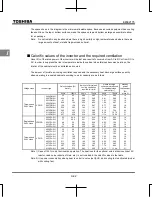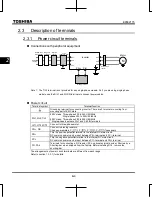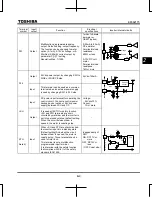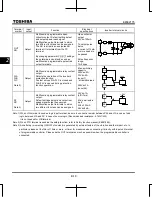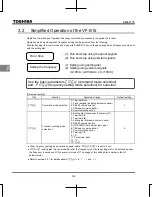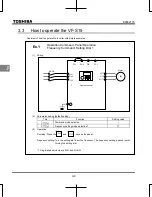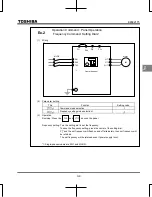
E6582175
B-7
2
2.3.2
Control circuit terminals
The control circuit terminal block is common to all equipment.
Regarding to the function and specification of each terminal, please refer to the following table.
Refer to section 1.3.3.3) about the arrangement of control circuit terminals.
Control circuit terminals
Terminal
symbol
Input /
output
Function
Electrical
specifications
Inverter internal circuits
F
Input
Mu
ltifu
n
ction
p
rog
ra
m
ma
b
le
log
ic in
pu
t
Shorting across F-CC or P24-F
causes forward rotation; open
causes deceleration stop.
(When Standby ST is always ON)
3 different functions can be
assigned.
No voltage
logic input
24Vdc-5mA or less
Sink/Source and
PLC selectable
using slide switch
SW1
(Default setting is
PLC side)
Pulse train input
(S2 terminal)
Pulse frequency
range:
10pps~2kpps
Duty: 50
±
10%
PTC input
(S3 terminal)
+24V
F
R
RES
S1
S2
EXT
SW1
SINK
SOURCE
VIB
SW2
S3
4.75k
1k
S3
S4
+5V
4.75k
22k
S3
27.4k
SW2
+5V
PTC
R
Input
Shorting across R-CC or P24-R
causes reverse rotation; open
causes deceleration stop.
(When Standby ST is always ON)
3 different functions can be
assigned.
RES
Input
This inverter protective function is
reset if RES-CC or P24-RES is
connected. Shorting RES-CC or
P24-RES has no effect when the
inverter is in a normal condition.
2 different functions can be
assigned.
S1
Input
Shorting across S1-CC or P24-S1
causes preset speed operation.
2 different functions can be
assigned.
S2
Input
Shorting across S2-CC or P24-S2
causes preset speed operation.
By changing parameter
f146
setting, this terminal can also be
used as a pulse train input terminal.
S3
Input
Shorting across S3-CC or P24-S3
causes preset speed operation.
By changing slide switch SW2 and
parameter
f147
setting, this
terminal can also be used as a PTC
input terminal.
Summary of Contents for TOSVERT VF-S15 series
Page 394: ......






